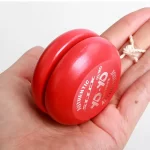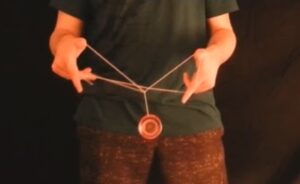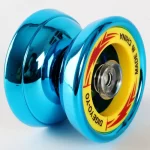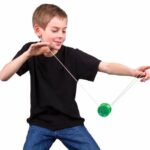
 I think every kid has played with a yo-yo at one time or another, but the reality is that the yo-yo was not originally designed to be a toy. It was actually a weapon used in the Philippian jungle. The original yo-yo was not designed by, but rather was promoted by DF Duncan Sr who was also the co-patent holder of a four-wheel hydraulic automobile brake and the marketer of the first successful parking meter. In addition, he was the genius behind the first premium incentive where you sent in two cereal box tops and received a toy rocket ship. He was quite the success, nevertheless, Duncan is best known for promoting the first great yo-yo fad in the United States.
I think every kid has played with a yo-yo at one time or another, but the reality is that the yo-yo was not originally designed to be a toy. It was actually a weapon used in the Philippian jungle. The original yo-yo was not designed by, but rather was promoted by DF Duncan Sr who was also the co-patent holder of a four-wheel hydraulic automobile brake and the marketer of the first successful parking meter. In addition, he was the genius behind the first premium incentive where you sent in two cereal box tops and received a toy rocket ship. He was quite the success, nevertheless, Duncan is best known for promoting the first great yo-yo fad in the United States.
Duncan was not the inventor of the yo-yo. They have been around for over twenty-five hundred years…who knew. The yo-yo is hailed as the second oldest toy in history, second only to the doll. The yo-yo was made out of wood, metal, and terra cotta when used in ancient Greece. Around 1800, the yo-yo moved into Europe from the Orient. It was not always called a yo-yo either, of course. The British called the yo-yo the bandalore, quiz, or the Prince of Wales toy. The French used the name incroyable or l’emigrette. “Yo-yo” is actually a Tagalog word, the native language of the Philippines, and means “come back.” While it appeared on the European scene in 1800, it was actually in the Philippines, being used as a weapon for over 400 years. The Philippian version was large with sharp edges and studs and attached to thick twenty-foot ropes for flinging at enemies or prey. The fact that it was attached to a rope is truly about the only real similarity to the yo-yos of today.
In the 1860s, people in the United States started playing with the British bandalore, but it was not until the  1920s that Americans first heard the word yo-yo. That was when Philippian immigrant, Pedro Flores, began manufacturing a toy labeled yo-yo. With that, Flores became the first person to mass-produce toy yo-yos, at his small toy factory located in California. Duncan saw the Flores toy and liked it. He bought the rights from Flores in 1929, then trademarked the name “Yo-Yo” and a true fad was born. Of course, Duncan also made some improvements to the toy, first adding the slip string, which consisted of a sliding loop around the axle instead of a knot. With this revolutionary improvement, the yo-yo could do a trick called “sleep” for the first time. The original shape, first introduced to the United States was the imperial or standard shape, but later, Duncan introduced the butterfly shape, a design that reverses the halves of a traditional imperial yo-yo. The butterfly shape allowed the player to catch the yo-yo on the string easily, which expanded the tricks it could do. With that, the yo-yo gained the popularity most of us remember it for.
1920s that Americans first heard the word yo-yo. That was when Philippian immigrant, Pedro Flores, began manufacturing a toy labeled yo-yo. With that, Flores became the first person to mass-produce toy yo-yos, at his small toy factory located in California. Duncan saw the Flores toy and liked it. He bought the rights from Flores in 1929, then trademarked the name “Yo-Yo” and a true fad was born. Of course, Duncan also made some improvements to the toy, first adding the slip string, which consisted of a sliding loop around the axle instead of a knot. With this revolutionary improvement, the yo-yo could do a trick called “sleep” for the first time. The original shape, first introduced to the United States was the imperial or standard shape, but later, Duncan introduced the butterfly shape, a design that reverses the halves of a traditional imperial yo-yo. The butterfly shape allowed the player to catch the yo-yo on the string easily, which expanded the tricks it could do. With that, the yo-yo gained the popularity most of us remember it for.
Donald Duncan saw huge potential in the yo-yo, and he worked out a deal with the newspaper tycoon William Randolph Hearst to get free advertising in Heart’s newspapers. Duncan traded advertising for competitions that required the entrants to bring a number of new subscriptions for the newspaper as their entry fee.
The first Duncan Yo-Yo was the O-Boy Yo-Yo Top, the toy with a big hit with people of all ages. Duncan’s massive factory produced 3,600 yo-yos every hour making the factory’s hometown of Luck, Wisconsin the Yo-Yo 
 Capital of the World. Duncan’s early media blitzes were so successful that in Philadelphia alone, three million units sold during a month-long campaign in 1931. Nevertheless, as with most toys, the next big thing comes along and the sales drop. The yo-yo was no exception to the rule. Basically, yo-yo sales went up and down as often as the toy, however, it is said that in order to recover their losses in the 1930s, Lego company decided, after being stuck with a huge inventory of yo-yos decided to salvage the unsold toys by sawing each yo-yo in half and using them as wheels on toy trucks and cars.
Capital of the World. Duncan’s early media blitzes were so successful that in Philadelphia alone, three million units sold during a month-long campaign in 1931. Nevertheless, as with most toys, the next big thing comes along and the sales drop. The yo-yo was no exception to the rule. Basically, yo-yo sales went up and down as often as the toy, however, it is said that in order to recover their losses in the 1930s, Lego company decided, after being stuck with a huge inventory of yo-yos decided to salvage the unsold toys by sawing each yo-yo in half and using them as wheels on toy trucks and cars.


Leave a Reply